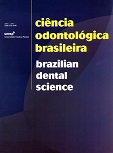Estudo fotomicrográfico do desgaste de pontas diamantadas em diferentes substratos
DOI:
https://doi.org/10.14295/bds.2004.v7i4.241Abstract
Foi avaliado, por meio de fotomicrografias, o desgaste de pontas diamantadas utilizando-se dois tipos de dentes: humano e bovino. Para isso, foi realizado um estudo in vitro com 72 dentes, sendo 36 molares humanos e 36 incisivos centrais bovinos. Realizaram-se desgastes na superfície de esmalte dos dentes com pontas diamantadas da marca KG Sorensen nº1092 totalizando 12 minutos de desgaste por dente. As pontas foram limpas com escova de aço e água e analisadas e fotografadas em lupa estereoscópica a cada totalização de tempo (12 minutos) e retornaram aos experimentos anteriores até completarem 72 minutos de uso por ponta diamantada. As fotomicrografias foram analisadas por três profissionais especializados onde foram atribuídos escores de 0 a 2 conforme a característica de sua ponta ativa. Os dados foram tabulados em Excel 2000 e foi ajustada uma regressão linear. O resultado encontrado mostra que no dente bovino a regressão foi de Y=0,133333+0,036111X e no humano, Y=0,233333+0,038889X, o que indica uma diminuição 7% mais rápida do número de diamantes das pontas usadas nos dentes humanos em relação às usadas nos bovinos, e também que as pontas perderam efetividade de corte a partir dos 48 minutos de uso em dentes humanos e 60 minutos em bovinos. Concluiu-se que o desgaste das pontas diamantadas em dentes humanos ocorre com menor tempo de uso, e que os dentes humanos são diferentes dos dentes bovinos com relação à resistência ao desgaste.Downloads
Downloads
Published
How to Cite
Issue
Section
License
Brazilian Dental Science uses the Creative Commons (CC-BY 4.0) license, thus preserving the integrity of articles in an open access environment. The journal allows the author to retain publishing rights without restrictions.
=================




























